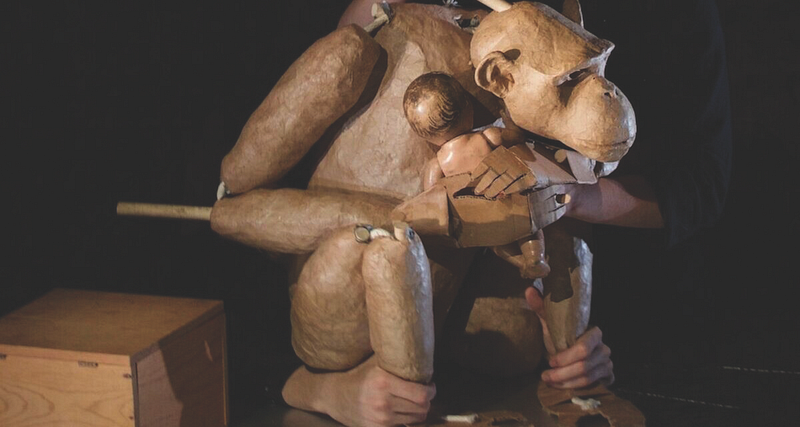
The weekend of Oct. 25 and 26, the Hamilton College Performing Arts Series organized a showing of Nick Lehane’s
Chimpanzee
. Lehane drew inspiration for the nonverbal puppet performance from stories of chimpanzees who were raised in foster homes like human children but lived their adulthood in biomedical testing facilities. The protagonist of the show is a chimpanzee who grew up from infancy alongside a human family — the setting of the performance alternates between her childhood memories and her adult life in a cage.
Three master puppeteers operate the life-sized model chimpanzee. Rowan Magee, Andy Manjuck, and Emma Wiseman each control different parts of the puppet, working completely in sync. The chimpanzee climbs, walks, and gestures with apparent ease, and the puppeteers continually express the chimpanzee’s emotions through her breathing patterns. She pants when anxious, sighs in defeat, and breathes evenly when relaxing in her human home. The puppeteers also alter the chimpanzee’s movement patterns according to the setting. Her body is visibly tense when she is confined to a cage, but in the scenes from her childhood, she is balletic and carefree.
Skillful light and sound design anchors the narrative of
Chimpanzee
. Lighting designer Marika Kent characterizes the chimpanzee’s life in a cage with harsh fluorescent light, accompanied by clanging sounds and animal cries in the background. The appearance of warm yellow light signals the scene transitions between the cage and the chimpanzee’s human home, and sound designer Kate Marvin indicates this change in setting by replacing the grating industrial soundtrack with birdsong and music.
In one scene, the sound of water boiling in a kettle accompanies the chimpanzee’s first attempt at making tea. In the same way a young child might, the chimpanzee tries to drink the tea before it’s cooled down. After burning her hand, she quickly learns her lesson. The scenes from the chimpanzee’s childhood allows the audience to observe her learning process. Like a human child, the young chimpanzee experiments with dressing up with scarves and dubiously watches her first fireworks show. She even learns from a book, under the guidance of an unseen human teacher.
These familiar scenes of childhood experiences endear the chimpanzee to the viewer. She is capable of learning and builds an understanding of the world around her. There are a few poignant moments where she experiences physical touch from a human, such as when her caretakers pat her on the head, hold her hand, and tuck her into bed. During her childhood experiences, the chimpanzee becomes immersed in the human world, and she is given ‘human’ status by her loved ones.
The return of harsh blue light symbolizes the revocation of the chimpanzee’s humanity. In contrast to the tea-drinking scene, her caretakers at the biomedical facility feed her out of a dog bowl. Human footsteps audibly circle the cage, but the chimpanzee receives no physical attention. The sounds of other chimpanzees screaming only reminds the audience of the protagonist’s isolation. As the memories of her childhood become more intense, the chimpanzee’s reaction to the cage also gets stronger. She experiences panic, with ragged breathing, restlessness, and moments of intense hopelessness. In a fit of physical frustration, she kicks at the doors and purposely hits her head against the walls. She collapses on the floor and, in a wrenching moment, attempts to hug herself for comfort.
Chimpanzee
interrogates the boundaries between species and questions the definition of humanity. As a child, the protagonist was treated as though she were human, and once that status is revoked, the audience must bear witness to the chimpanzee’s grief. The chimpanzee’s ability to learn enabled her to participate in a human version of childhood: she knows what it means to be human, and therefore grasps the full extent to which society has rejected her. Through masterful puppetry and staging, the tragic narrative of
Chimpanzee
brings the audience into a debate over the fundamental definition of humanity.

















